If there’s one piece of gear you won’t regret spending more money and time trying, it will be hiking boots.
In this post:
- Recommended Hiking Boots
- Other Good Hiking Boots
- Hiking Boot Tips
- Buying Guide: Fit
- Buying Hiking Boots
- Hiking Boots vs Trail Runners
- Hiking Boot Glossary
- Other Backpacking Gear
Recommended Hiking Boots
First up, our favourite boots. There are definitely other boot options out there but we’ve tested these in the past and like them.
Editors Choice: Tecnica Forge Hiking Boot

The Tecnica Forge heat moldable hiking boot
Our current favourite hiking boots. Tecnica has brought their heat-moldable boot technology from ski boots and has made the best fitting hiking boot we’ve ever tried. Where other boots don’t fit quite right, the Forge is heat-molded and fits very well with uncommonly shaped feet.
The Gore-Tex membrane provides excellent waterproofing. Thick lugs on the outside provide good grip in wet, slipper conditions. The thin kevlar laces have a rough texture that’s a little rough in the hand but this keeps them locked in place after tying.
Salomon X Ultra 3 Mid Hiking Boot
The X Ultra 3 Mid hiking boot from Salomon is our pick for a mid-sized hiker. They have a great general fit off the bat, fitting most feet no problem. We never recommend long hikes with new boots but you might be able to with these. The only downside is the mid size which doesn’t waterproof or protect as high as taller boots (but does keep the weight down). The Quest 4D 3 GTX boot is the taller step up from the X Ultra 3.
At our local outdoors shop this is always one of their best-selling boots.
Other Good Hiking Boots
Hi-Tec Sierra Lite I WP hiking boots
Another mid-sized hiker from Sierra is a great option for any kind of hike or snowshoe. I hiked the
Full review: Hi-Tec Sierra Lite I WP hiking boots
Hiking Boot Tips
- How to Prevent Sore Feet HikingHiking isn’t much fun when you have sore feet. There are so many different things that can cause sore feet… Read More »How to Prevent Sore Feet Hiking
- How to buy hiking bootsYou head into the local outdoor store to the boot wall. There’s at least 50 different options. Instant overwhelm. You… Read More »How to buy hiking boots
- How to Prevent Painful Blisters (and Treat Them Too)Blisters are an awful part of hiking but they don’t have to be. They hurt. They slow you down. They… Read More »How to Prevent Painful Blisters (and Treat Them Too)
- Hiking Boots vs Shoes: What do you need to hike?Hiking boots have been around for over 100 years now. Up until the 80s hikers wore hiking boots and that… Read More »Hiking Boots vs Shoes: What do you need to hike?
- Can You Hike in Trail Runners?Yes! You can absolutely hike in trail runners. Trail runners work very well for hiking. They are lightweight, comfortable, breathable… Read More »Can You Hike in Trail Runners?
- Wet Feet or Not: Are Hiking Boots Waterproof?Some hiking boots are waterproof and some are not. If a boot has a waterproof membrane inside then it should… Read More »Wet Feet or Not: Are Hiking Boots Waterproof?
- How to Clean Hiking BootsWait. Hiking boots are supposed to get dirty aren’t they? So why are we trying to clean them? First, why… Read More »How to Clean Hiking Boots
- How to Break in Hiking BootsYou just pulled your brand new hiking boots out of the box. Stoke is high to get on the trail… Read More »How to Break in Hiking Boots
- How to Re-waterproof Hiking BootsHiking boots come from the factory with a waterproof coating on the outside. It’s not what makes it actually waterproof… Read More »How to Re-waterproof Hiking Boots
Buying Guide: Fit
Fit is the most important factor when looking for boots. The boots could be a great price and have all the features you need but if they don’t fit, you’ll end up with blisters and sore feet every hike.
Blisters can happen anywhere on your foot but the most common spot is the heel. When your boot doesn’t fit well, your heel will slide up and down every step inside your boot. This creates a blister and sometimes rubs the skin right off. We probably don’t need to say how painful these are! Every step hurts.
So how should hiking boots fit? Look for these warning signs when trying on boots.
Heel slides up and down
If your heel slides up when down when you walk then you’re sure to get a blister. Tie your boots snug but not so tight it’s painful and your heel should not slide up and down and your foot should not slide left and right in your boot.
Pulling laces quite snug at your ankle here can help. If the top of your foot hurts or your foot starts going to sleep then it’s too tight. See if you can either lace the bottom looser and the top tighter or snug all the way up to get a good fit.
All boots are built on different molds and some will just be different than your foot. Try as many boots on as you can. Boots should fit very well right away.
Hotspots or pressure points
When walking around home or the store with a new pair of boots on watch out for parts that press hard against your foot. Everything should be soft and smooth inside. Over thousands of steps on a hike, any pressure points are going to hurt. Common pressure points are on the top of the boots where the laces are and sides around the toes. Loosening the laces a bit can help on top but not so much your foot slips around when walking. A boot should feel like a warm hug on your feet.
Toes are cramped
Toes need breathing room. Feet swell up after hours on the trail. They need a bit of room to slide forward when you’re walking downhill so they don’t get hammered into the end of your boot.
When you’re trying boots on, try them on at the end of a long day after you’ve walked a lot. Your foot might be a half size larger than in the morning. Find a good incline to walk down and see if your toes hit the end. If your toenails are being scraped off then it’s time to size up or look for a different model.
Try lacing differently
To change the fit of your boots, you can adjust the lacing along the top of your foot and at the ankle. You can lace your foot loosely and then your ankle tight. If your ankle gets loose during the hike you can try a double overhand knot (wrapping the lace around itself twice) at your ankle and then continuing to lace up your leg. This separates the foot part of the boot from the leg part and lets you pull one tighter than the other.
Breaking in boots
With leather hiking boots, the old stories say you should soak a pair of boots in the water and walk them dry. But the end of the walk the boot will be perfect formed to your foot and you’ll never see a blister.
Boots do need a bit of a break-in period but it shouldn’t take long. Ideally you can find a pair of boots that fit well right out of the box. Leather boots will still continue to form around your feet as you hike and they warm up.
Don’t hike with brand new boots!
Don’t do big hikes that is.
While those boots may feel great right of the box, try to do shorter hikes and then work up to longer ones with brand new boots. Your feet are still getting used to them and they are still breaking in around your specific foot shape. There may be a case where you need brand new boots right before a big hike but always try to get used to them and break them in first.
Try all the pairs on
Try on as many as you can. Many shops will let you walk around the shop for a while to test them out. Ask about return policy as you might be able to wear them at home inside and still return them (clean!) if they don’t fit. A huge benefit to your high quality local outdoor store is good boot-fitting and being able to try things on before you buy. an indication of a good outdoors shop is they’ll give you all the time you need to make a good decision.
Buying Hiking Boots
Of course even hiking boots have specs and features that we can look at for each boot.
Material
The materials boots can make a difference in how well they feel but the exact material won’t make much of a difference. There are amazing boots both made out of leather and synthetic. Leather typically molds to your foot a bit better over time because of the supple nature of the material. Don’t use that to avoid synthetic though. If a boot fits, it fits.
Manufacturers all use different food models, or lasts, to make their boots. They’ll even use different lasts between boot lines. I try to find brands that fit my feet well and stick with those. These can change over time.
Waterproofing
Many hiking boots are waterproof and this is one of the reasons to wear them. You can stomp through puddles, mud and snow without getting your feet wet. How boots stay waterproof is different.
Some boots have a waterproof membrane inside like Gore-Tex or eVent. The water is blocked by the waterproof membrane.
Other boots are just leather and don’t have a waterproof membrane inside. Leather can be coated with waxes that cause water to run off. They aren’t 100% waterproof but most of the time the wax prevents your feet from getting wet.
Taller boots will provide higher waterproofing. Boots are usually waterproof up to where the tongue splits from the side of the boot. Sometimes they split very low, reducing the waterproof height. Look for the height of the split to see how high the waterproofing goes.
Mid boot or tall?
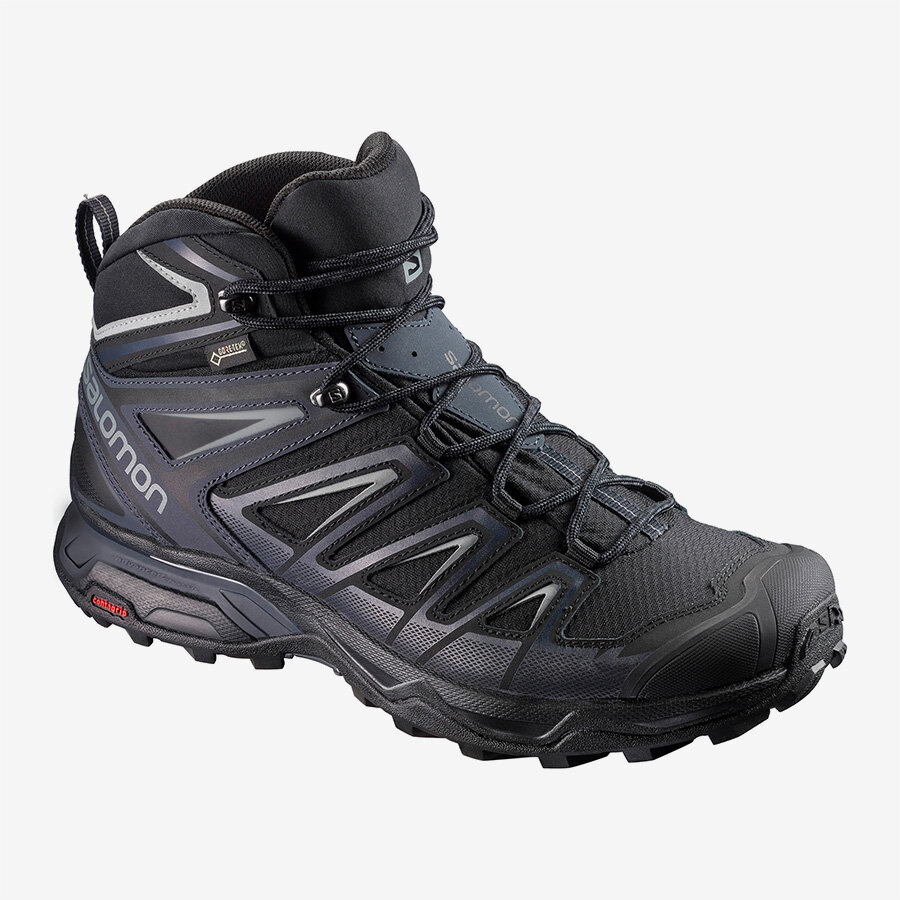
X Ultra 3 Mid from Salomon.com
Many boots are called a Mid or mid-sized boot and rather than being full height (and weight) they are 3/4 or middle sized. The X Ultra 3 Mid from Salomon is a good example of this. They only only have 2 lace hooks near the top of the boot because they aren’t as tall as a full sized boot. This makes them lighter than full boots but less supportive. They tend to be waterproof up to a lower level than full-height boots as well.
Weight
Hiking boots should be as light as possible for the features you need. There’s no sense in lugging around extra weight on your feet if you don’t need to.
There are cases where you’d like heavier boots. Taller and more supportive boots will be heavier. Boots with thicker soles or a shank (stiffener) in the midsole will be heavier. Waterproof boots will be heavier. If you want any of these features in a boot then it will be heavier than versions without.
At the end of the day, we try to take the lightest pair of boots that has the features you want.
Hiking Boots vs Trail Runners
Hiking boots aren’t the only option for footwear on your adventures. Trail runners are becoming more popular as lightweight options. What’s the difference?
Let’s look at hiking boots first. They’re taller for waterproofing, more supportive through the ankle and often built to withstand the rigors of hundreds of kilometres on the trail.
Trail runners are lighter, more flexible and can be more breathable in warm weather.
Which one should you pick?
It’s entirely up to you whether you hike in boots or trail runners. We tend to have both boots and shoes, wearing each depending on the weather and the trail.
Hiking boots are nice when the weather sucks. They’ll keep your feet dryer and warmer when it’s wet or snowy. If you know it’s going to be raining or you’ll be walking through puddles, streams or mud, boots can keep your feet dry. Boots also provide more ankle support. If the trail is rough, the chances of a rolled ankle will increase. You can limit or prevent those injuries with taller boots.
Hiking boots also tend to have thicker, more supportive midsoles and outsoles. This prevents the rocks and roots from pounding your feet on a long hike. Hiking with a heavy overnight pack only makes this worse. Multi-day hikes are definitely a good time to take the hiking boots.
When the weather is dryer, you’re moving faster or your pack is lighter, then trail runners would be our choice. They are more comfortable, lighter weight and breathe better.
If you’re new to backpacking, light hiking boots will be your best friend. Until you know exactly what you like doing and how you like to pack, light hikers will keep your feet safe and dry.
Regardless of which you pick, hiking boot or trail runner, fit should be the most important thing.
Hiking Boot Glossary
There’s a lot of terms to know when looking up hiking boots. Here’s a quick rundown of some you may run across
Eyelet: A small metal or plastic ring, d-ring or hook that holds the lace on a boot.
Outsole: The rubber outer sole of a hiking shoe or boot.
Membrane: Waterproof boots usually have a boot made of waterproof fabric inside that keeps the water out. This is called the membrane.
Lugs: Grippy bumps on the bottom of the outsole for grip.
Shank: A stiff material in the midsole, sometimes metal or plastic to make the boot more stiff.
eVent: A waterproof membrane sometimes used in hiking boots and shoes.
Hiking Boot Reviews
- Tecnica Forge GTX Hiking Boot ReviewHiking boots can be tough to recommend to other people. What fits my foot may not fit yours. That’s not… Read More »Tecnica Forge GTX Hiking Boot Review
Other Backpacking Gear
You’ll need more than just hiking boots to head out backpacking. Here are buying guides to all the other gear you need for backpacking.
- EXPED MegaMat LXW Sleeping Pad ReviewCamping is so much better when you get a good night sleep. With backpacking, hiking all day almost guarantees a good night sleep. But with… Read More »EXPED MegaMat LXW Sleeping Pad Review
- Backpacking Gear for Beginners CourseWelcome to the Backpacking Gear for Beginners Course. This course will walk you through every piece of hiking gear you might need for a short… Read More »Backpacking Gear for Beginners Course
- Backpacking Gear for Beginners: DishesThis post is part of the Backpacking Gear for Beginners course. Why do you need dishes? You probably want to eat while you’re backpacking, right? That usually… Read More »Backpacking Gear for Beginners: Dishes
- Backpacking Gear for Beginners: Sleeping GearThis post is part of the Backpacking Gear for Beginners course. This is where we start to get into the differences between day hiking and backpacking. Day… Read More »Backpacking Gear for Beginners: Sleeping Gear
- Backpacking Gear for Beginners: Waterproof JacketThis post is part of the Backpacking Gear for Beginners course. Why do you need a waterproof jacket? It’s hard to stay warm when you’re wet. A… Read More »Backpacking Gear for Beginners: Waterproof Jacket
- Backpacking Gear for Beginners: FirestarterThis post is part of the Backpacking Gear for Beginners course. Why do you need a firestarter? Part of the 10 Essentials is something to light fire… Read More »Backpacking Gear for Beginners: Firestarter
- Backpacking Gear for Beginners: TentThis post is part of the Backpacking Gear for Beginners course. Other options are a hammock with a tarp over it, or just a tarp over a… Read More »Backpacking Gear for Beginners: Tent
- Backpacking Gear for Beginners: Waterproof PantsThis post is part of the Backpacking Gear for Beginners course. Why do you need waterproof pants? Just as you need a waterproof jacket for your hike,… Read More »Backpacking Gear for Beginners: Waterproof Pants
- Backpacking Gear for Beginners: Batteries and Battery PacksThis post is part of the Backpacking Gear for Beginners course. Why do you need batteries and a battery pack? Most people take things hiking that require… Read More »Backpacking Gear for Beginners: Batteries and Battery Packs
- Backpacking Gear for Beginners: Sleeping MatThis post is part of the Backpacking Gear for Beginners course. Why do you need a sleeping mat? Since you’re going to be sleeping outside, you need… Read More »Backpacking Gear for Beginners: Sleeping Mat
- Backpacking Gear for Beginners: SocksThis post is part of the Backpacking Gear for Beginners course. Why do you need socks? Chances are slim that you can wear hiking boots or walk… Read More »Backpacking Gear for Beginners: Socks
- Backpacking Gear for Beginners: SoapThis post is part of the Backpacking Gear for Beginners course. Why do you need soap? Soap is optional on the trail but it’s nice to have.… Read More »Backpacking Gear for Beginners: Soap
- Backpacking Gear for Beginners: The 10 EssentialsThis post is part of the Backpacking Gear for Beginners course. Pack the 10 Essentials The 10 Essentials is a short list of essentials for… Read More »Backpacking Gear for Beginners: The 10 Essentials
- Backpacking Gear for Beginners: Sleeping BagThis post is part of the Backpacking Gear for Beginners course. Why do you need a sleeping bag? Sleeping outside is going to get a little chilly.… Read More »Backpacking Gear for Beginners: Sleeping Bag
- Backpacking Gear for Beginners: HatThis post is part of the Backpacking Gear for Beginners course. Why do you need a hat? Hats aren’t required but they are nice to have in… Read More »Backpacking Gear for Beginners: Hat
- Backpacking Gear for Beginners: Garbage BagThis post is part of the Backpacking Gear for Beginners course. Why do you need garbage bags? Most trails don’t have garbage bins every kilometer so you’ll… Read More »Backpacking Gear for Beginners: Garbage Bag
- Backpacking Gear for Beginners: BackpackThis post is part of the Backpacking Gear for Beginners course. Why do you need a backpack? Backpacking is all about what you can carry… Read More »Backpacking Gear for Beginners: Backpack
- Backpacking Gear for Beginners: PillowThis post is part of the Backpacking Gear for Beginners course. Why do you need a pillow? Obviously you need to put your head on something when… Read More »Backpacking Gear for Beginners: Pillow
- Backpacking Gear for Beginners: Other Backpacking GearThis post is part of the Backpacking Gear for Beginners course. There are many items we can take backpacking that are more or less optional but are… Read More »Backpacking Gear for Beginners: Other Backpacking Gear
- Backpacking Gear for Beginners: Tips to StartThis post is part of the Backpacking Gear for Beginners course. That’s the end of the gear section. You now have enough knowledge to be dangerous to… Read More »Backpacking Gear for Beginners: Tips to Start
What is Your Best Boot Tip?
Have any good tips or stories to share about hiking boots? Share it it with us below! New hikers would love to hear your best tips about lacing, sizing or fixing boots.

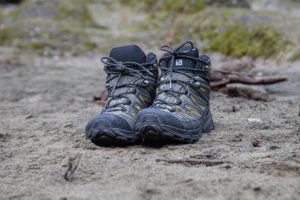

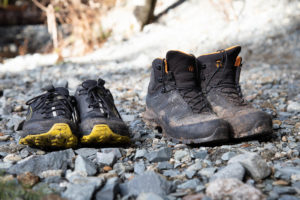
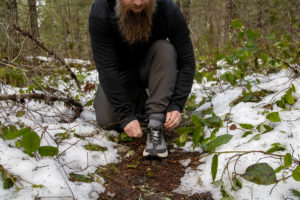
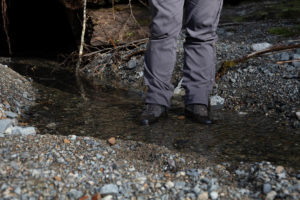
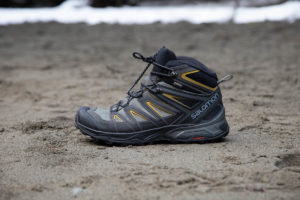
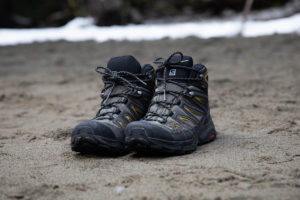
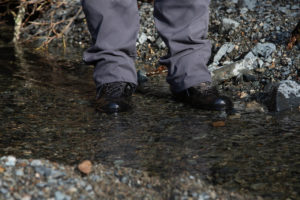
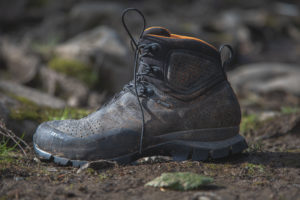
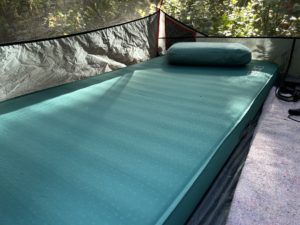
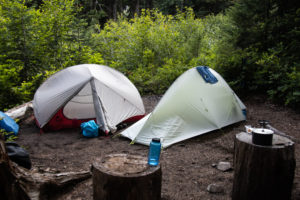
I desperately needed this post. Thank you very much for publishing this post.